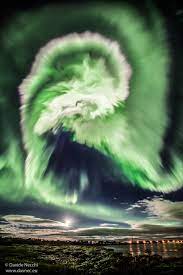Aurora Glow Observed Above Iceland:

Stunning aurora glow was recently observed above Iceland after a ‘dead’ sunspot erupted.
- An Aurora is a display of light in the sky predominantly seen in the high latitude regions (Arctic and Antarctic). It is also known as a Polar light.
- There are two types- the aurora borealis and aurora australis – often called the northern lights and southern lights.
- They commonly occur at high northern and southern latitudes, less frequent at mid-latitudes, and seldom seen near the equator.
- While usually a milky greenish color, auroras can also show red, blue, violet, pink, and white.
- These colors appear in a variety of continuously changing shapes.
- Auroras are a spectacular sign that our planet is electrically connected to the Sun.
- These light shows are provoked by energy from the Sun and fueled by electrically charged particles trapped in Earth’s magnetic field.
- The typical aurora is caused by collisions between fast-moving electrons from space with the oxygen and nitrogen in Earth’s upper atmosphere.
- The electrons—which come from the Earth’s magnetosphere, the region of space controlled by Earth’s magnetic field —transfer their energy to the oxygen and nitrogen atoms and molecules, making them “excited”.
- As the gases return to their normal state, they emit photons, small bursts of energy in the form of light.
- When a large number of electrons come from the magnetosphere to bombard the atmosphere, the oxygen and nitrogen can emit enough light for the eye to detect, giving us beautiful auroral displays.
- They origin at altitudes of 100 to more than 400 km.
- The color of the aurora depends on which gas — oxygen or nitrogen — is being excited by the electrons, and on how excited it becomes.
- The color also depends upon how fast the electrons are moving, or how much energy they have at the time of their collisions.
- High energy electrons cause oxygen to emit green light (the most familiar color of the aurora), while low energy electrons cause a red light. Nitrogen generally gives off a blue light.
- The blending of these colors can also lead to purples, pinks, and whites.
- The oxygen and nitrogen also emit ultraviolet light, which can be detected by special cameras on satellites.




